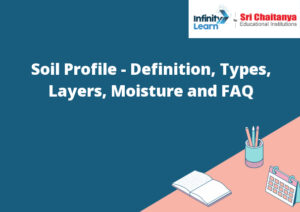Table of Contents
Soil Profile – Definition
Soil Profile – Definition: A soil profile is a vertical section of soil, starting at the surface and going down to the bedrock. The profile includes all the different layers of soil, as well as the different materials that make up each layer.
- Soil profiles are used to study the different properties of soil, including its texture, color, and moisture content. They can also be used to study the changes that occur in soil over time, as well as the effects of different environmental factors.

Soil Profile Definition
Soil profile is a cross-section of soils at a particular location, showing the different layers of soil and their characteristics. The layers are typically identified by their color, texture, and chemical composition.
Formation of Soil
- The process of soil formation is a combination of physical, chemical, and biological processes that occur over a period of time. The most important factor in soil formation is the climate.
- Soil is created when rocks break down and weather. The rocks are broken down by physical weathering, which is caused by the physical forces of wind, water, ice, and gravity. Chemical weathering, which is the breaking down of rocks by chemical processes, also contributes to the formation of soil.
- The biological process of soil formation is called humification. This process is caused by the action of bacteria, fungi, and other organisms that break down the organic matter in the rocks. The organic matter is then combined with minerals to form soil.
Different Types of Soil
- There are six different types of soil: sand, silt, clay, loam, chalk, and peat.
- Each type of soil has different characteristics that make it ideal for certain types of plants. For example, clay soil is good for plants that need a lot of water, because the soil holds moisture well. Loam soil is good for plants that need a lot of nutrients, because the soil is rich in minerals.
- Each type of soil has its own unique properties, which is why it is important to know what type of soil you are planting in.
Layers of Soil
- The soil is made up of different layers, each with its own characteristics. The top layer, called the surface layer or topsoil, is the layer that is most affected by weather and other environmental factors. It is also the layer where most of the plant growth takes place. The topsoil is made up of organic materials, such as leaves and twigs, as well as mineral materials, such as sand and clay.
- The next layer down is the subsoil. This layer is not as affected by the weather as the topsoil and it contains less organic material. The subsoil is made up of different types of rocks, such as sandstone, shale, and limestone.
- The layer below the subsoil is the bedrock. This is the layer of rocks that make up the earth’s surface. The bedrock is made up of solid rocks, such as granite and basalt.
Types of Soil based on the Texture
The three types of soil textures are sand, silt, and clay.
- Sandy soils have larger particles and feel gritty when rubbed between your fingers.
- Silt soils have smaller particles and feel smooth.
- Clay soils have the smallest particles and feel sticky.
What is Soil Moisture?
Soil moisture is the water that is stored in the soil. The water in the soil can be used by plants to grow and to survive. The water in the soil can also be used by people to water their plants.
Types of Soil Moisture
There are three types of soil moisture:
1. Gravitational moisture: This is the water held in soil by the force of gravity. This water is available to plants.
2. Capillary moisture: This is the water held in soil by capillary action. This water is available to plants.
3. Field capacity: This is the maximum amount of water a soil can hold. After this point, the soil becomes saturated and water will start to drain from the surface.
Importance of Soil Moisture
Soil moisture is important to plants, because it is necessary for the uptake of water and nutrients. Soil moisture is also necessary for the growth of plant roots.
How to measure Soil Moisture?
There are a few ways to measure soil moisture:
- Soil moisture meter: A soil moisture meter is a tool that measures the water content in the soil. It has a probe that is inserted into the soil, and it will give a reading of the soil moisture content.
- Feel the soil: You can also feel the soil to see if it is wet or dry. If the soil feels wet, it has high moisture content. If the soil feels dry, it has low moisture content.
- Look at the soil: You can also look at the soil to see if it is wet or dry. If the soil is wet, it has high moisture content. If the soil is dry, it has low moisture content.
What is Soil Erosion ?
Soil erosion is the process of land degradation by the action of wind and water.
How to prevent Soil Erosion?
There are many ways to prevent soil erosion. Mulching, planting ground cover, and using retaining walls are all effective methods.









